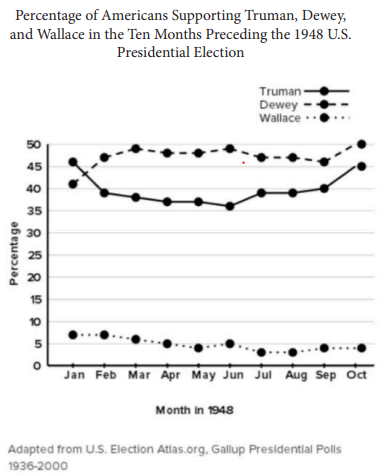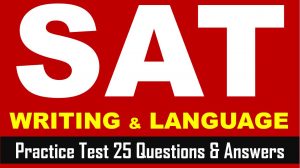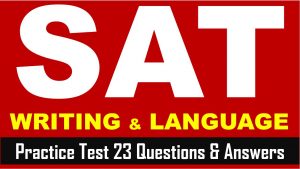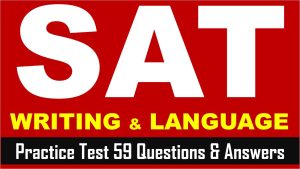Hi SAT Aspirants, welcome to AKVTutorials. As you know SAT (Scholastic Assessment Test) is a standard test, used for taking admission to undergraduate programs of universities or colleges of United States. SAT is developed and published by the College Board, an organization in United States, administered by the Educational Testing Service. Therefore, you need to do practice on SAT Reading Section, SAT Writing and Language Section. In this article, you will get SAT Language and Writing Practice Test 67 with Answer Keys AMBIPi.
Instruction:
- In the passage below is accompanied by a number of questions.
- For some questions, you need to think how the passage might be revised to improve the expression of ideas.
- For other questions, you will consider how the passage might be edited to correct errors in sentence structure, usage, or punctuation.
- Some questions will direct you to an underlined portion of a passage.
- Other questions will direct you to a location in a passage or ask you to think about the passage as a whole.
SAT Writing & Language Section Passage
SAT Language and Writing Practice Test Passage Title: Truman’s Winning Whistle-Stop Tour
[1] In 1948, United States President Harry S. Truman faced reelection for a second term, but the polls predicted he would lose. [2] Since the end of World War II three years earlier, the US economy had been unsteady. n[3] Citizens had trouble finding and purchasing goods due to shortages. [4] Many people felt a fresh face on the political scene in this uncertain time would be welcome. [5] As the campaign moved into high gear in May of 1948, Truman lagged 11 percent behind Dewey in the polls. [6] Instead, the polls favored New York Governor Thomas E. Dewey, Truman’s charismatic opponent and a welcome change in an economically turbulent post-war climate. [7] However, Truman would engage in a hard-fought, unorthodox campaign style that became known as the first successful “whistle-stop” tour. 1
Using train travel in a political campaign was a fairly common practice that had begun in the nineteenth 2 century. The specific term “whistle stop” wasn’t coined until Truman used it to describe his whirlwind campaign tour. 3 Truman, delivered hundreds of speeches in towns across the United States from an open platform on the back of his train car.
His arduous travels 4 were covering 30,000 miles and over 200 train stops, starting in the summer of 1948 and ending that fall before the November 2nd election. He began the tour in Michigan, then moved on to Iowa, Ohio, Missouri, Kansas, and Colorado as the summer progressed. In September, he headed west to Nevada, Utah, California, and Arizona. At one of his stops in 5 Arizona. An estimated 20,000 people waited to greet him at the train station. In October, he headed back east again to Oklahoma, Illinois, Kentucky, West Virginia, and Pennsylvania.
6 Truman would make as many as eight stops in a single day. He spoke to thousands of voters 7 of a time, but the nature of the whistle stop campaign allowed voters to glimpse a more intimate view of the candidate.
By coming to voters’ hometowns and speaking directly to them, Truman presented himself as a “man of the people.” 8 Truman marketed himself as 9 attainable— making himself available to discuss local political issues with the residents of the small towns he visited.
By November, newspapers and the Gallup poll were still predicting Dewey as the winner. However, the success of Truman’s whistle-stop tours had helped to close the gap. 10 When voters went to the polls, Truman won the 11 election which is considered the greatest upset in a US presidential race, due to his exhaustive campaign.

SAT Language and Writing Practice Test Questions
Question No 1
To make the first paragraph most logical, sentence 6 should be placed
Option A : where it is now.
Option B : after sentence 1.
Option C : after sentence 2.
Option D : after sentence 7.
Answer
Show/Hide Answer
Option B : after sentence 1.
Question No 2
Which choice most effectively combines the sentences at the underlined portion?
Option A : century, but
Option B : century; also,
Option C : century, so
Option D : century; meanwhile,
Answer
Show/Hide Answer
Option A : century, but
Question No 3
Which choice provides the most effectively transition to the information that follows?
Option A : No Change
Option B : Truman delivered hundreds of speeches in towns
Option C : Truman delivered: hundreds of speeches, in towns
Option D : Truman delivered hundreds of: speeches in towns
Answer
Show/Hide Answer
Option B : Truman delivered hundreds of: speeches in towns
Question No 4
Which choice results in the most effective transition to the information that follows in the paragraph?
Option A : No Change
Option B : cover
Option C : will cover
Option D : covered
Answer
Show/Hide Answer
Option D : covered
Question No 5
Which choice best maintains the sentence pattern already established in the paragraph?
Option A : No Change
Option B : Arizona, an estimated 20,000 people waited
Option C : Arizona, an estimated 20,000 people waiting
Option D : Arizona, with an estimated 20,000 people waiting
Answer
Show/Hide Answer
Option B : Arizona, an estimated 20,000 people waited
Question No 6
Which choice provides the most effective transition from the previous paragraph to this one?
Option A : To cover so much territory,
Option B : Because of the limitations of train travel,
Option C : In spite of his attempts to cover a large territory,
Option D : In order to speak out against his opponent,
Answer
Show/Hide Answer
Option A : To cover so much territory,
Question No 7
Which choice best maintains the sentence pattern already established in the paragraph?
Option A : No Change
Option B : on the
Option C : at a
Option D : of the
Answer
Show/Hide Answer
Option C : at a
Question No 8
Which choice provides the best supporting details for claim made in the previous sentence?
Option A : He told jokes, spoke without flourish, and even introduced his family to the onlookers.
Option B : He traveled in the presidential train car and was able to visit many constituents’ hometowns.
Option C : He spoke to the citizens from the raised platform of his expansive train car.
Option D : He emphatically enumerated the reasons that his opponent was not the best candidate.
Answer
Show/Hide Answer
Option A : He spoke to the citizens from the raised platform of his expansive train car.
Question No 9
Which choice best maintains the sentence pattern already established in the paragraph?
Option A : No Change
Option B : plausible
Option C : approachable
Option D : palatable
Answer
Show/Hide Answer
Option C : approachable
Question No 10
The writer wants to include accurate and relevant information from the graph to support the preceding sentence. Which choice best accomplishes this goal?
Option A : In October, Truman was still trailing Dewey
Option B : Truman suffered a setback in the polls from January to March of 1948.
Option C : By the end of the campaign, Truman only lagged by five percent in the polls, a significant improvement from his 11 percent lag in May.
Option D : Dewey and Truman’s poll numbers both far surpassed Wallace’s.
Answer
Show/Hide Answer
Option C : By the end of the campaign, Truman only lagged by five percent in the polls, a significant improvement from his 11 percent lag in May.
Question No 11
Which choice completes the sentence with accurate data based on the graph?
Option A : No Change
Option B : election, which is considered the greatest upset in a US presidential race,
Option C : election which is considered, the greatest upset in a US presidential race
Option D : election, which is considered the greatest upset, in a US presidential race
Answer
Show/Hide Answer
Option B : election, which is considered the greatest upset in a US presidential race,



